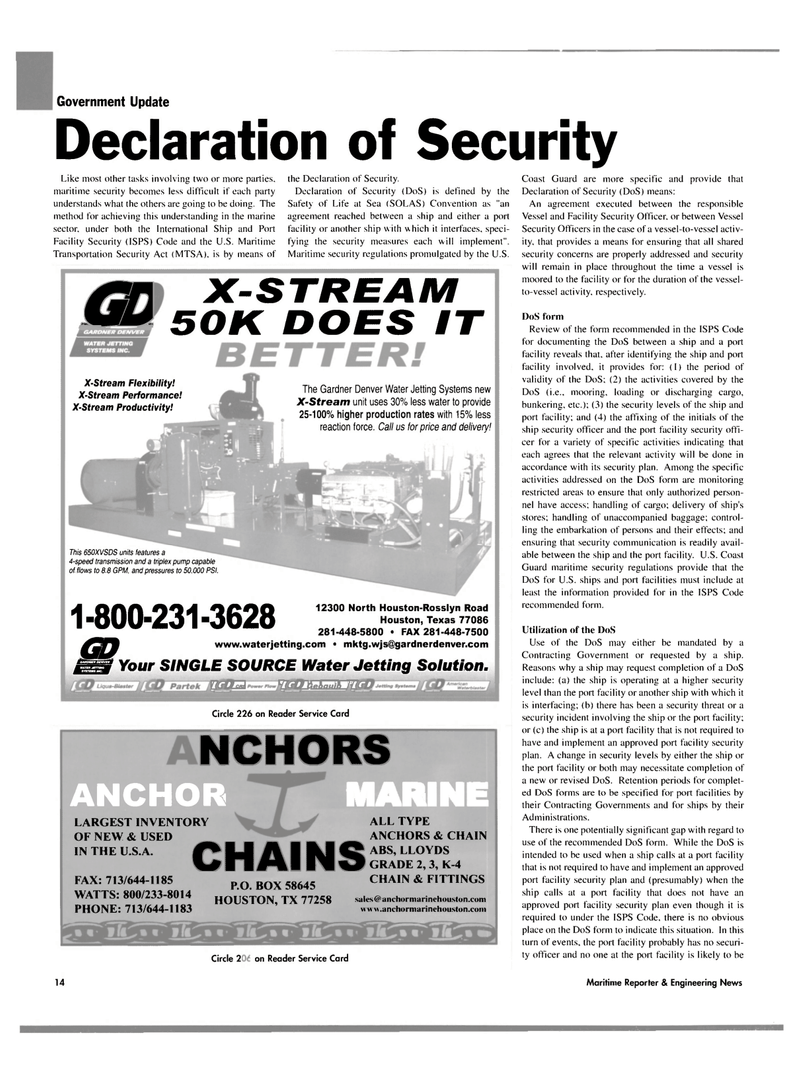
Page 14: of Maritime Reporter Magazine (August 2004)
65th Anniversary Edition
Read this page in Pdf, Flash or Html5 edition of August 2004 Maritime Reporter Magazine
Government Update
Declaration of Security
Like most other tasks involving two or more parties, maritime security becomes less difficult if each party understands what the others are going to be doing. The method for achieving this understanding in the marine sector, under both the International Ship and Port
Facility Security (ISPS) Code and the U.S. Maritime
Transportation Security Act (MTSA). is by means of the Declaration of Security.
Declaration of Security (DoS) is defined by the
Safety of Life at Sea (SOLAS) Convention as "an agreement reached between a ship and either a port facility or another ship with which it interfaces, speci- fying the security measures each will implement".
Maritime security regulations promulgated by the U.S.
Coast Guard are more specific and provide that
Declaration of Security (DoS) means:
An agreement executed between the responsible
Vessel and Facility Security Officer, or between Vessel
Security Officers in the case of a vessel-to-vessel activ- ity, that provides a means for ensuring that all shared security concerns are properly addressed and security will remain in place throughout the time a vessel is moored to the facility or for the duration of the vessel- to-vessel activity, respectively.
DoS form
Review of the form recommended in the ISPS Code for documenting the DoS between a ship and a port facility reveals that, after identifying the ship and port facility involved, it provides for: (I) the period of validity of the DoS: (2) the activities covered by the
DoS (i.e., mooring, loading or discharging cargo, bunkering, etc.); (3) the security levels of the ship and port facility; and (4) the affixing of the initials of the ship security officer and the port facility security offi- cer for a variety of specific activities indicating that each agrees that the relevant activity will be done in accordance with its security plan. Among the specific activities addressed on the DoS form are monitoring restricted areas to ensure that only authorized person- nel have access; handling of cargo; delivery of ship's stores; handling of unaccompanied baggage; control- ling the embarkation of persons and their effects; and ensuring that security communication is readily avail- able between the ship and the port facility. U.S. Coast
Guard maritime security regulations provide that the
DoS for U.S. ships and port facilities must include at least the information provided for in the ISPS Code recommended form.
Utilization of the DoS
Use of the DoS may either be mandated by a
Contracting Government or requested by a ship.
Reasons why a ship may request completion of a DoS include: (a) the ship is operating at a higher security level than the port facility or another ship with which it is interfacing; (b) there has been a security threat or a security incident involving the ship or the port facility; or (c) the ship is at a port facility that is not required to have and implement an approved port facility security plan. A change in security levels by either the ship or the port facility or both may necessitate completion of a new or revised DoS. Retention periods for complet- ed DoS forms are to be specified for port facilities by their Contracting Governments and for ships by their
Administrations.
There is one potentially significant gap with regard to use of the recommended DoS form. While the DoS is intended to be used when a ship calls at a port facility that is not required to have and implement an approved port facility security plan and (presumably) when the ship calls at a port facility that does not have an approved port facility security plan even though it is required to under the ISPS Code, there is no obvious place on the DoS form to indicate this situation. In this turn of events, the port facility probably has no securi- ty officer and no one at the port facility is likely to be
GD X-STREAM 50K DOES IT
X-Stream Flexibility!
X-Stream Performance!
X-Stream Productivity!
The Gardner Denver Water Jetting Systems new
X-Stream unit uses 30% less water to provide 25-100% higher production rates with 15% less reaction force. Call us for price and delivery!
This 650XVSDS units features a 4-speed transmission and a triplex pump capable of flows to 8.8 GPM. and pressures to 50.000 PSI. 1-800-231-3628
CD 12300 North Houston-Rosslyn Road
Houston, Texas 77086 281-448-5800 • FAX 281-448-7500 www.waterjetting.com • [email protected] iSP Your SINGLE SOURCE Water Jetting Solution. inm 'ir>i,u.mi.m ic>
Circle 226 on Reader Service Card
NCHORS
ANCHOR
LARGEST INVENTORY
OF NEW & USED
IN THE U.S.A.
MARINE
CHAINS
FAX: 713/644-1185
WATTS: 800/233-8014
PHONE: 713/644-1183
P.O. BOX 58645
HOUSTON, TX 77258
ALL TYPE
ANCHORS & CHAIN
ABS, LLOYDS
GRADE 2, 3, K-4
CHAIN & FITTINGS [email protected] www.anchormarinehouston.com
Circle 272 on Reader Service Card 14 Maritime Reporter & Engineering News

 13
13

 15
15
